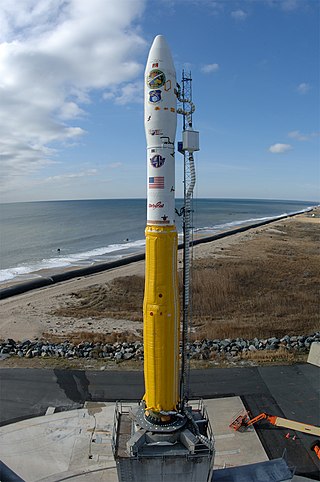Minotaur I
Space launch vehicle From Wikipedia, the free encyclopedia
The Minotaur I, or just Minotaur is an American expendable launch system derived from the Minuteman II missile.[1] It is used to launch small satellites for the US Government, and is a member of the Minotaur family of rockets produced by Orbital Sciences Corporation (now Northrop Grumman).[2]
 Minotaur I with NFIRE at MARS | |
| Function | Small expendable launch system |
|---|---|
| Manufacturer | Northrop Grumman |
| Country of origin | United States |
| Size | |
| Height | 19.21 metres (63.0 ft) |
| Diameter | 1.67 metres (5 ft 6 in) |
| Mass | 36,200 kilograms (79,800 lb) |
| Stages | 4 or 5 |
| Capacity | |
| Payload to LEO | |
| Mass | 580 kilograms (1,280 lb) |
| Payload to SSO | |
| Mass | 331 kilograms (730 lb) |
| Launch history | |
| Status | Active |
| Launch sites | Vandenberg SLC-8 MARS LP-0B |
| Total launches | 13 |
| Success(es) | 13 |
| First flight | 27 January 2000 |
| Last flight | 18 June 2024 |
| First stage – M55A1 | |
| Powered by | 1 Solid |
| Maximum thrust | 935 kilonewtons (210,000 lbf) |
| Propellant | Solid |
| Second stage – SR19 | |
| Powered by | 1 Solid |
| Maximum thrust | 268 kilonewtons (60,000 lbf) |
| Propellant | Solid |
| Third stage – Orion 50XL | |
| Powered by | 1 Solid |
| Maximum thrust | 118.2 kilonewtons (26,600 lbf) |
| Burn time | 74 seconds |
| Propellant | Solid |
| Fourth stage – Orion 38 | |
| Powered by | 1 Solid |
| Maximum thrust | 34.8 kilonewtons (7,800 lbf) |
| Burn time | 68 seconds |
| Propellant | Solid |
Vehicle
The Minotaur I is the follow-on to the Orbital Sciences' Taurus (later renamed the "Minotaur-C"[3]) launch vehicle, combining the original Taurus's booster stage with a second stage from a Minuteman missile.[4]
Minotaur I rockets consist of the M55A1 first stage and SR19 second stage of a decommissioned Minuteman missile.[1] The Orion 50XL and Orion 38, from the Pegasus rocket, are used as third and fourth stages. A HAPS (Hydrazine Auxiliary Propulsion System) upper stage can also be flown if greater precision is needed, or the rocket needs to be able to manoeuvre to deploy multiple payloads.[5] It can place up to 580 kilograms (1,280 lb) of payload into a 185-kilometer (115 mi) low Earth orbit at 28.5 degrees of inclination.[1]
The Minotaur I is 69 feet tall and 5 feet wide.[6]
Initially Minotaur I launches are conducted from Space Launch Complex 8 at the Vandenberg Air Force Base. Starting with the launch of TacSat-2 in December 2006, launches have also been conducted from Pad 0B at the Mid-Atlantic Regional Spaceport on Wallops Island.[5]
Launch history
Summarize
Perspective
There have been thirteen launches of the Minotaur I, all successful.
| Flight | Date (UTC) | Payload | Launch pad | Trajectory | Result |
|---|---|---|---|---|---|
| 1 | January 27, 2000 03:03:06 | JAWSat (P98-1) (FalconSat1 / ASUSat1 / OCSE / OPAL) | Vandenberg SLC-8 | LEO | Success[7] |
| 2 | July 19, 2000 20:09:00 | MightySat II.1 (Sindri, P99-1) / MEMS 2A / MEMS 2B | Vandenberg SLC-8 | LEO | Success[8] |
| 3 | April 11, 2005 13:35:00 | XSS-11 |  Vandenberg SLC-8 | LEO | Success[9] |
| 4 | September 23, 2005 02:24:00 | Streak (STP-R1) |  Vandenberg SLC-8 | LEO | Success[10] |
| 5 | April 15, 2006 01:40:00 | COSMIC (FORMOSAT-3) | Vandenberg SLC-8 | LEO | Success[11] |
| 6 | December 16, 2006 12:00 | TacSat-2 / GeneSat-1 |  MARS LP-0B | LEO | Success[12] |
| 7 | April 24, 2007 06:48 | NFIRE |  MARS LP-0B | LEO | Success[13] |
| 8 | May 19, 2009 23:55 | TacSat-3 |  MARS LP-0B | LEO | Success[14] |
| 9 | February 6, 2011 12:26 | USA-225 (NROL-66) |  Vandenberg SLC-8 | LEO | Success[15] |
| 10 | June 30, 2011 03:09 | ORS-1 |  MARS LP-0B | LEO | Success[16] |
| 11 | November 20, 2013 01:15 | ORS-3,[17] STPSat-3 and 28 CubeSat satellites[18] |  MARS LP-0B | LEO | Success[19] |
| 12 | June 15, 2021 13:35 | NROL-111 | MARS LP-0B | LEO | Success[20] |
| 13 | June 18, 2024 07:01 |
Mk21A reentry vehicle test |  Vandenberg TP-01 |
Suborbital | Success[21] |
See also
References
Wikiwand - on
Seamless Wikipedia browsing. On steroids.
